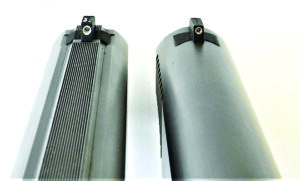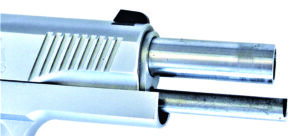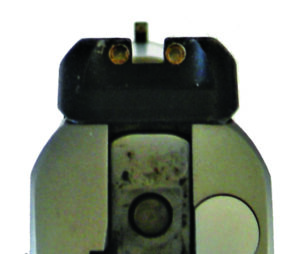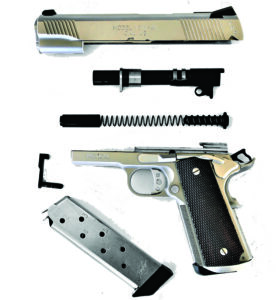After testing five high-end 1911 handguns in the July 2020 issue, we got four more guns to conduct an even greater and more demanding test of steel. The 1911 handgun has continued in service, even at the top of the heap, in competition and service use long after other mechanical designs have been out of service or relegated to the museum. A low bore axis, straight-to-the-rear trigger compression, a grip that fits most hands well, and a design that lends itself well to customization has the potential to suit every shooter. Among expensive 1911 handguns, the primary difference in the pistols isn’t the number of features, although self-luminous sights and extended controls have a bearing on price. Rather, the reason they are so expensive is the quality of machine work and manufacture. The trigger compression, barrel fit, and frame-to-slide fit are usually as good as human hands can make them, and the cosmetics are almost always top notch. Such guns will almost always be able to outshoot their owners, and their operation is flawlessly reliable.
All of the pistols tested are 5-inch-barrel steel-frame 1911 handguns. This means they are not difficult to control with full-power ammunition. Our contestants were:
- The Dan Wesson Specialist 01802 45 ACP, $1732. We found a Specialist “on sale” for $1575 and moved too late to obtain it, and we also located a few for $2020. It seems $1700 is about average. Our test gun cost us a bit more than the Springfield and a thousand dollars less than the Wilson Combat and Les Baer, on average. While the Dan Wesson may be a “production” pistol, unless the pistol is modified one at a time by a custom pistolsmith, most high-end 1911 handguns are products of a certain package or formula, so its factory SKU didn’t put us off one bit. The Dan Wesson Specialist is the heaviest 1911 tested at 43 ounces unloaded — just three ounces less than a 6-inch-barrel 357 Magnum Python.
- The Les Baer 572 Hemi 45 ACP, $2853. This pistol is named after Les Baer’s drag car. It is a distinctive pistol with a chrome finish, black grips, and black Dupont S coated controls. Some of the raters were left cold by the color scheme, others were very enthusiastic, it is that type of pistol. The pistol features both standard and forward cocking serrations. They are nicely machined with a finer pattern than the other handguns.
- The Springfield Armory 1911 TRP PC9107L18 45 ACP, $1648. We found this pistol listed for $1299 at several outlets, but also saw it as out of stock. The Tactical Response Pistol is a factory-production 1911 turned out by the Springfield custom shop. You cannot upgrade a Loaded Model by gunsmithing it into a TRP; the TRP is a tighter gun. The frame is fitted to the slide, and the result is a very tight pistol — it seemed as tight as the Wilson Combat or Dan Wesson pistols.
- The Wilson Combat Close Quarters Battle 45 ACP, $2865. The Close Quarters Battle is the flagship combat pistol offered by Wilson Combat. The CQB is manufactured using the same parts you might order to build your own Wilson Combat pistol, save the parts fitted in house by Wilson Combat gunsmiths. A trademark of the CQB is excellent barrel fitting. The barrel-to-slide and bushing fit are tight, and the barrel crown is well done. This pistol’s steel frame and slide have an Armor Tuff coating that is evenly applied and seems durable, we thought.

These are four different handguns with different downrange performance, but the bottom line connecting them is reliability. To check for this, we fired the 80 rounds of ammunition on the combat course, mixing up the lot with mostly practice loads, 40 rounds of Black Hills Ammunition 200-grain LSWCs, 20 rounds of Fiocchi 230-grain FMJs, and 20 rounds of a handload consisting of the Hornady 230-grain XTPs over enough Titegroup powder for 855 fps.
Among the guns, the Les Baer 572 Hemi is primarily designed for extreme accuracy. The Wilson Combat CQB is a formidable defensive firearm. The Dan Wesson Specialist is for service use. The Springfield Tactical Response pistol is intended to offer excellent performance, but it isn’t as expensive as the Springfield Professional, which is an FBI SWAT pistol, and it was deemed a good match on the lower end of high-end prices.
Gun Tests Grade: B
$1648
The test pistol is stainless steel. The fit and finish are good; however, there was an apparent tool mark near the rear of the trigger guard where the pistol is marked “SS” for stainless steel. If you prefer a darker finish, the pistol may be had in Armory Kote. We had an Armory Kote pistol belonging to one of the raters on hand for comparison. It is a nicely finished pistol, and is, in all regards, similar to the TRP tested.
| Action Type | single action, short recoil-operated locked breech |
| Overall Length | 8.5 in. |
| Overall Height | 5.5 in. |
| Maximum Width | 1.25 in. |
| Weight Unloaded | 40.0 oz. |
| Weight Loaded | 45.0 oz. |
| Slide Material | Forged steel |
| Slide Retraction Effort | 19.5 lbs. |
| Receiver Material | Stainless steel |
| Finish | Stainless steel |
| Front Strap Height | 2.6 in. |
| Back Strap Height | 3.2 in. |
| Barrel Length | 5.0 in. |
| Grip Thickness Maximum | 1.25 in. |
| Grip Circumference | 5.2 in. |
| Magazines | Two 8-round |
| Rear Sight | Tritium insert, drift-adjustable Novak |
| Front Sight | Dovetailed post, tritium insert |
| Sight Radius | 6.4 in. |
| Trigger Pull Weight | 6.1 lbs. |
| Trigger Span | 2.8 in. |
| Safeties | Slide lock, grip |
| Warranty | Limited lifetime |
| Telephone | (309) 944-5631 |
| Website | Springfield-Armory.com |
| Made In | Brazil; finished in U.S.A. |

The barrel is outsourced, and while Springfield will not divulge the source, those in the know tell us it is a Storm Lake, an excellent choice. The trigger is an aluminum type with an overtravel stop. This pistol features a magazine well and checkered front strap. The fit of the slide, frame, and controls are excellent. The grip safety properly releases its holds on the trigger halfway into compression. The trigger breaks cleanly at 6.1 pounds. The beavertail may not be as high as the Wilson Combat’s, but it is the equal of the other pistols. The trigger is the heaviest of the four 1911s, but it doesn’t feel heavy or gritty at 6.1 pounds.

The two-piece guide rod isn’t the most popular feature, but it was a popular option when the Tactical Response Pistol was first designed. The pistol is supplied with two padded-base magazines that mate nicely with the magazine well. The TRP’s slide features forward and rear cocking serrations. The sights were state of the art when the TRP was designed and are still excellent choices with a Novak Lo-Mount rear sight and three-dot tritium inserts, with two in the rear and one on the front post.
While front-strap checkering is good to have, of the four pistols, the Springfield TRP’s checkering was the only one uncomfortable to hold for long periods and too abrasive. More of us work with a keyboard instead of a jackhammer, and this is a consideration. The answer is to wear gloves when firing the pistol for any length of time. A concern for the validity of the test was that the pistol was delivered with a set of Springfield checkered wooden grips of the Springfield Mil Spec type, while the specifications call for V10-type grips. (We see this type of thing often these days. As one example, a new-in-the-box Kimber was delivered with a Metalform magazine, which is fine, but Kimber magazines have been supplied with every other Kimber tested.)

On the firing range, the pistol’s 20-lpi front-strap checkering provided a sure grip platform. The pistol is fast on target and offers excellent control. In combat shooting, the Tactical Response Pistol seemed to perform as well as the others, although the Wilson Combat CQB was the best performer, but you have to work for the results. In common with the Les Baer, the Springfield’s slide-lock safety is set to be hard on the upsweep to the Safe position.
We grew tired of wrestling with the full-length guide rod during disassembly and changed the system out for a standard guide rod and recoil spring. One of the raters fired the pistol again afterward and noticed no loss of accuracy. While we did not care for the full-length guide rod, we did not rate the pistol down because some believe the FLGR is an aid to accuracy and function.
Our Team Said: The pistol is accurate, but it is limited by the heavier trigger action. Combat groups were good, but, overall, the more expensive 1911 handguns with lighter trigger actions performed better. A few rounds fired at 50 yards in a side test confirmed this. The pistol’s accuracy off the bench rest was good, if not exciting, with some groups inside of 2 inches. It is an accurate pistol, but the least accurate tested.
45 ACP Range Data
All groups were fired at 25 yards from a benchrest position using a MTM Caseguard K Zone pistol rest. We used a Competition Electronics Pro Chrony to measure velocity. The first screen of the chronograph was 10 feet from the muzzle.| Black Hills 230-grain JHP | Les Baer Hemi 572 | Wilson Combat CQB | Dan Wesson Specialist | Springfield TRP |
| Average Velocity | 870 fps | 855 fps | 861 fps | 863 fps |
| Muzzle Energy | 387 ft.-lbs. | 373 ft.-lbs. | 379 ft.-lbs. | 380 ft.-lbs. |
| Small Group | 0.9 in. | 1.5 in. | 1.8 in. | 2.0 in. |
| Average Group | 1.5 in. | 1.9 in. | 2.3 in. | 2.6 in. |
| Fiocchi 230-grain JHP | Les Baer Hemi 572 | Wilson Combat CQB | Dan Wesson Specialist | Springfield TRP |
| Average Velocity | 842 fps | 853 fps | 839 fps | 840 fps |
| Muzzle Energy | 362 ft.-lbs. | 372 ft.-lbs. | 359 ft.-lbs. | 360 ft.-lbs. |
| Small Group | 2.2 in. | 2.3 in. | 2.4 in. | 2.7 in. |
| Average Group | 2.6 in. | 2.6 in. | 2.8 in. | 3.0 in. |
| Handload Hornady 185-grain XTP | Les Baer Hemi 572 | Wilson Combat CQB | Dan Wesson Specialist | Springfield TRP |
| Average Velocity | 1125 fps | 1160 fps | 1140 fps | 1137 fps |
| Muzzle Energy | 520 ft.-lbs. | 553 ft.-lbs. | 534 ft.-lbs. | 531 ft.-lbs. |
| Small group | 1.3 in. | 1.4 in. | 1.9 in. | 1.7 in. |
| Average Group | 1.6 in. | 1.8 in. | 2.2 in. | 2.0 in. |


























